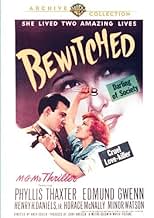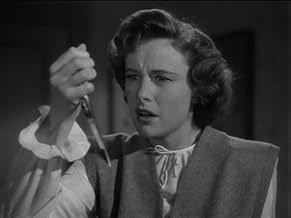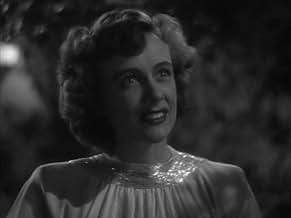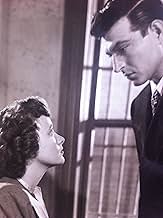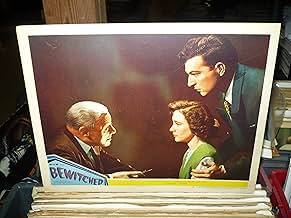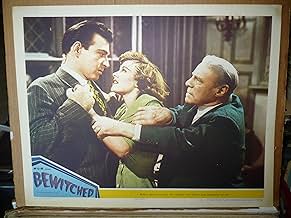AVALIAÇÃO DA IMDb
5,6/10
741
SUA AVALIAÇÃO
Adicionar um enredo no seu idiomaA young woman has two distinct personalities, one of whom is evil and constantly gets her in trouble.A young woman has two distinct personalities, one of whom is evil and constantly gets her in trouble.A young woman has two distinct personalities, one of whom is evil and constantly gets her in trouble.
Stephen McNally
- Eric Russell
- (as Horace McNally)
Tom Coleman
- Juror
- (não creditado)
Clancy Cooper
- Cop
- (não creditado)
Eddie Dunn
- Prison Janitor
- (não creditado)
George Meader
- Juror
- (não creditado)
Howard M. Mitchell
- Juror
- (não creditado)
Avaliações em destaque
I'm giving this a seven, because it's cinematically well crafted. I was very interested to see how it would end, given that the Production Code ensured that virtue would be rewarded-- so would the Code let anyone get away with murder?
The film's theme of split personality suffers from a profound ignorance of that disorder's mechanics, and confuses it with certain forms of schizophrenia, an error still common today. Schizophrenia is a psychosis, a mental illness treatable with medication, while Multiple Personality Disorder, now known as Dissociative Identity Disorder, is an acquired condition usually formed as a survival mechanism after unbearable trauma. In Bewitched it manifests more like demonic possession.
Dissociative Identity was first identified in the 1880s, but was still largely a mystery to many people. The idea of split personality readily leant itself to dramatic portrayal, especially onscreen, and this served to familiarize more of the general public with the condition. There was Blanche Sweet in "The Case of Becky" (1915) from the stage success by that name, remade in 1918 as "The Two-Soul Woman" with Priscilla Dean. Still to come were Constance Binney in a remake of "The Case of Becky" in 1921, followed by Gladys Walton in "The Untameable" (1923). Barbara La Marr took on a new treatment of the theme in "Sandra" (1924). More familiar today would of course be 1957's "The Three Faces of Eve" and later titles.
I couldn't help wondering why the poor girl never mentioned hearing that nasty voice in her head. Of course she didn't want people thinking she was CRAZY, so she just went on acting really disturbed, which had to suggest that she was-- well, DISTURBED.
The story makes no sense in psychological terms, so it's best not to worry about its half-baked medical aspects. Just figure that this nice girl somehow picked up a demon who wanted to take over. The demon 'Karen' is a vicious maneating floosy, itching to be set loose upon the world, and giving her Audrey Totter's voice makes her truly scary. If Karen ever got more than a few moments in control, woe to us all!
The film's theme of split personality suffers from a profound ignorance of that disorder's mechanics, and confuses it with certain forms of schizophrenia, an error still common today. Schizophrenia is a psychosis, a mental illness treatable with medication, while Multiple Personality Disorder, now known as Dissociative Identity Disorder, is an acquired condition usually formed as a survival mechanism after unbearable trauma. In Bewitched it manifests more like demonic possession.
Dissociative Identity was first identified in the 1880s, but was still largely a mystery to many people. The idea of split personality readily leant itself to dramatic portrayal, especially onscreen, and this served to familiarize more of the general public with the condition. There was Blanche Sweet in "The Case of Becky" (1915) from the stage success by that name, remade in 1918 as "The Two-Soul Woman" with Priscilla Dean. Still to come were Constance Binney in a remake of "The Case of Becky" in 1921, followed by Gladys Walton in "The Untameable" (1923). Barbara La Marr took on a new treatment of the theme in "Sandra" (1924). More familiar today would of course be 1957's "The Three Faces of Eve" and later titles.
I couldn't help wondering why the poor girl never mentioned hearing that nasty voice in her head. Of course she didn't want people thinking she was CRAZY, so she just went on acting really disturbed, which had to suggest that she was-- well, DISTURBED.
The story makes no sense in psychological terms, so it's best not to worry about its half-baked medical aspects. Just figure that this nice girl somehow picked up a demon who wanted to take over. The demon 'Karen' is a vicious maneating floosy, itching to be set loose upon the world, and giving her Audrey Totter's voice makes her truly scary. If Karen ever got more than a few moments in control, woe to us all!
This is a bold film for its time because it tackles mental illness head on - in this case multiple personality syndrome. Thaxter is quite good as the sweet young girl occasionally taken over by the evil Karin (voiced brilliantly by Audrey Totter). Unfortunately the director takes it all far too seriously, and his constant cut-aways to grim or shocked reaction shots becomes comical. You really feel for the actors. Thank God for the wonderful Edmund Gwenn, who is the only actor who makes the material almost believable. And what a great psychiatrist he is - he can cure multiple personality syndrome in a matter of seconds, just by talking sternly to the evil side! Some nice visual moments and the uniqueness of the material make this film worth a look.
Prototype Film-Noir from Stylist Arch Oboler who made His Name on the Radio with His Ultra-Popular "Lights Out" Program. Here He Adopts His Own Story "Alter-Ego" and brings it to the Screen for MGM.
This is One of the Few MGM Noirs of the First Wave. It would Take Years before the Haughty Studio would lend its Name Seriously to a Style so Dark.
Phyllis Thaxter gives a Good Performance in a Soul-Baring Role. Steve McNally is Miscast but manages to look Desperate and Edmund Gwenn as the Psychiatrist trying to Exorcise Thaxter's other Personality, the Evil One, is a Good Try.
With its Roots in Dr. Jekyll and Mr. Hyde, the only Reference Point at this Point for Multiple Personalities On Screen, Oboler delivers and Ultra-Stylish Descent into Schizophrenia.
The Film is Guilty of way too Much Verbiage, a Radio Drama influence, but it Balances it with Film Flourishes that are Atmospheric and Stunning.
The Movie Grips the Audience as it tries to Explain and Expose Psychiatric Methods and Procedures. But the Truth is that Not Much was Known at the Time and the Little that was Known was constantly Up for Debate in the Medical Community.
So it was No Easy Task Transferring this to the Movies. For Years Hollywood gave it a go with Extremely Inconsistent Results. It Was a Staple in Film-Noir and the Horror of Val Lewton but Main Stream and "A" Pictures were Reluctant to take it on for quite Some Time.
Overall, this is a Great Early Effort and a Striking Example of Film-Noir and the Psychological Pictures that Started a Run After the War and Never Stopped, and actually becoming a Genre of its own (The Psychological Thriller).
This is One of the Few MGM Noirs of the First Wave. It would Take Years before the Haughty Studio would lend its Name Seriously to a Style so Dark.
Phyllis Thaxter gives a Good Performance in a Soul-Baring Role. Steve McNally is Miscast but manages to look Desperate and Edmund Gwenn as the Psychiatrist trying to Exorcise Thaxter's other Personality, the Evil One, is a Good Try.
With its Roots in Dr. Jekyll and Mr. Hyde, the only Reference Point at this Point for Multiple Personalities On Screen, Oboler delivers and Ultra-Stylish Descent into Schizophrenia.
The Film is Guilty of way too Much Verbiage, a Radio Drama influence, but it Balances it with Film Flourishes that are Atmospheric and Stunning.
The Movie Grips the Audience as it tries to Explain and Expose Psychiatric Methods and Procedures. But the Truth is that Not Much was Known at the Time and the Little that was Known was constantly Up for Debate in the Medical Community.
So it was No Easy Task Transferring this to the Movies. For Years Hollywood gave it a go with Extremely Inconsistent Results. It Was a Staple in Film-Noir and the Horror of Val Lewton but Main Stream and "A" Pictures were Reluctant to take it on for quite Some Time.
Overall, this is a Great Early Effort and a Striking Example of Film-Noir and the Psychological Pictures that Started a Run After the War and Never Stopped, and actually becoming a Genre of its own (The Psychological Thriller).
A woman on death row is discovered to have a split personality in "Bewitched," a 1945 film starring Phyllis Thaxter, Edmund Gwenn, and Stephen McNally. Thaxter is a young, soon to be wed woman who has blackouts, walks around at night, and hears voices. She runs away from her parents' home and her husband to be and goes to New York, gets a job, and meets an attorney (McNally) who falls for her. Her fiancé finds her, and, under orders from her other personality (voiced by Audrey Totter), she kills him.
Now we're brought back to death row where Edmund Gwenn suspects her problem and wants to hypnotize her.
Boring film with a good cast nonetheless, psychiatric disorders being a fashionable subject during and after World War II. What made Three Faces of Eve interesting was that the main character was a woman with a dull affect, but her personalities had lots of spark. Just hearing the voice of Totter here isn't enough. If Thaxter had actually been taken over by her alternate personality and, say, lived as her in New York, the film would have been a lot more interesting.
Not very good.
Now we're brought back to death row where Edmund Gwenn suspects her problem and wants to hypnotize her.
Boring film with a good cast nonetheless, psychiatric disorders being a fashionable subject during and after World War II. What made Three Faces of Eve interesting was that the main character was a woman with a dull affect, but her personalities had lots of spark. Just hearing the voice of Totter here isn't enough. If Thaxter had actually been taken over by her alternate personality and, say, lived as her in New York, the film would have been a lot more interesting.
Not very good.
Wholesome gal Phyllis Thaxter lives with her upper-middle-class parents and plans to wed soon. But she's beginning to cause some concern; she's prone to odd fainting spells blackouts, really and to wandering the deserted streets of her midwestern city at night. Scant wonder, because living inside her, and clawing to get out, is Audrey Totter! Totter, in fact, gives perhaps the most chilling voice-of-the-demon performance until Mercedes McCambridge gave us Pazuzu in The Exorcist.
Capitalizing on the heightened interest in abnormal psychology spurred by the return of shell-shocked veterans, Bewitched latches onto a tabloid-worthy subject multiple personality disorder. It's noteworthy in doing so a dozen years before both Lizzie and The Three Faces of Eve, in which, respectively, Eleanor Parker and Joanne Woodward (who nabbed the Oscar) displayed similar symptoms. Footnotes in medical journals probably do not cite any of these movies, so facile is their treatment of a troubling and controversial syndrome.
Thaxter tries a geographical cure, fleeing to New York where she falls in love with a lawyer (Stephen McNally). But when her old fiancé tracks her down, Totter, who apparently wasn't left behind, emerges to kill him with a pair of scissors. Then comes a stylized courtroom fantasy lifted all but intact from Boris Ingster's Stranger On The Third Floor, followed by a real murder trial. Wise old psychiatrist Edmund Gwynne explains everything to us, along with the Governor and his wife, and then proceeds to exorcize Totter (who, by the way, calls herself Karen).
Apart from Thaxter's nocturnal excursion, there's little original or striking about the movie. That we see the good girl but only hear the bad one is a big part of the problem. The extra energy that might have come from seeing Karen in action for that matter, from casting Totter on-screen gets thrown away. They picked the wrong personality.
Capitalizing on the heightened interest in abnormal psychology spurred by the return of shell-shocked veterans, Bewitched latches onto a tabloid-worthy subject multiple personality disorder. It's noteworthy in doing so a dozen years before both Lizzie and The Three Faces of Eve, in which, respectively, Eleanor Parker and Joanne Woodward (who nabbed the Oscar) displayed similar symptoms. Footnotes in medical journals probably do not cite any of these movies, so facile is their treatment of a troubling and controversial syndrome.
Thaxter tries a geographical cure, fleeing to New York where she falls in love with a lawyer (Stephen McNally). But when her old fiancé tracks her down, Totter, who apparently wasn't left behind, emerges to kill him with a pair of scissors. Then comes a stylized courtroom fantasy lifted all but intact from Boris Ingster's Stranger On The Third Floor, followed by a real murder trial. Wise old psychiatrist Edmund Gwynne explains everything to us, along with the Governor and his wife, and then proceeds to exorcize Totter (who, by the way, calls herself Karen).
Apart from Thaxter's nocturnal excursion, there's little original or striking about the movie. That we see the good girl but only hear the bad one is a big part of the problem. The extra energy that might have come from seeing Karen in action for that matter, from casting Totter on-screen gets thrown away. They picked the wrong personality.
Você sabia?
- CuriosidadesAudrey Totter dubbed Thaxter's evil personality's voice.
- Citações
Joan Alris Ellis: Bob, do you hear... someone talking?
- ConexõesFeatured in The Late, Late Show: Bewitched (1962)
Principais escolhas
Faça login para avaliar e ver a lista de recomendações personalizadas
Detalhes
- Tempo de duração
- 1 h 5 min(65 min)
- Cor
- Proporção
- 1.37 : 1
Contribua para esta página
Sugerir uma alteração ou adicionar conteúdo ausente


